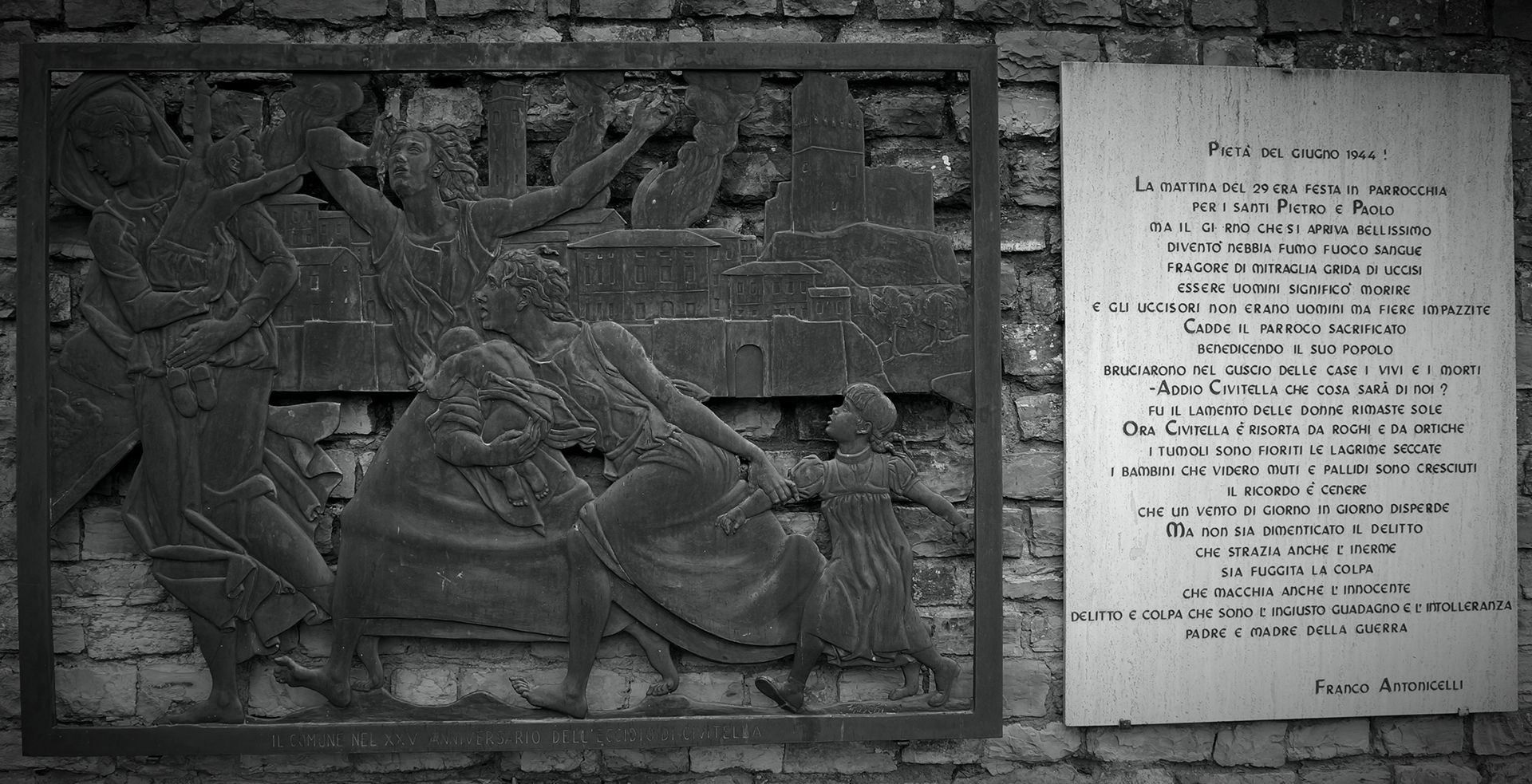The events of 29 June ’44. Civitella
The background
On the evening of June 18th, 1944, Sunday, nine German soldiers, perhaps paratroopers of “Hermann Göring” division, approached a farmhouse at the Madonna, near Civitella. After having dinner, they headed for the recreational club of the village and sat at a table, with their weapons on the ground. A group of partisans, learning that some German soldiers had entered the village, decided to disarm them. At about 9.00 pm, they entered the club. Here the versions diverge: some say that the partisans immediately opened fire, others instead favour an intimation of surrender, whereupon the Germans would react. In any case, there was a firefight and three Germans fell to the ground. One of them, unharmed, was able to escape. In the recreational club the confusion was at its highest, the civilians were fleeing from everywhere and someone had also been wounded. Two German soldiers were dead and one wounded.
At about 11.00 pm, a German soldier arrived to the farmhouse of the Madonna. He was carrying on his shoulders a comrade, the soldier wounded at the recreational club, who was washed and treated until his companions took him away on a truck. In the village, meanwhile, when the day broke, the population fled in terror fearing a retaliation. Meanwhile, the archpriest Don Alcide Lazzeri, learned of the incident and decided to wash the two dead Germans and organize their funeral with the few women he managed to find. But the Germans still didn’t react. On June 20th, a German officer arrived, perhaps a doctor, to examine the two bodies that were still lying in the club. With the aid of an interpreter, he listened to Don Lazzeri, who recalled the stages of the attack and said that the civilians weren’t guilty of what had happened. The officer accepted, as a sign of good will, that the two soldiers would be buried in the local cemetery, and so happened, with the participation of a picket of German soldiers. But still the intentions of the soldiers were not clear, and the villagers were afraid to return. After a series of investigations, the Germans went away. Indeed, some said to the inhabitants of Civitella to be calm, because there would be no reprisals. But instead, on the morning of June 29th, 1944, when for the feast of St. Peter and Paul many people had returned home, units of paratroopers of the armored division “Hermann Göring”, flanked by other soldiers, some of them Italians, surrounded the village at dawn. All men were captured in their homes and taken to the town square, among them don Lazzeri, who offered his life in exchange for that of the civilians. He wasn’t listened to: he was killed with a gunshot to the head as all the other 149 victims, including two priests. Then, the bodies were thrown into the houses of the village to which the Germans set fire.
The breadth of the operation and the number of units involved in the events of Civitella does not allow to establish exactly the time, but all the surviving witnesses agree in identifying the arrival of the German soldiers at around 5.30 am, when the families were preparing to go to Mass on the day of St. Peter and Paul. Among the aims of the operation there was certainly also the intent to slow the advancing of the Allied army, while the Germans were building in the Apennines the Gothic Line in defense of northern Italy.
The first to be killed were the inhabitants of the hamlets around Civitella. The houses of Palazzina, Querciola, Maestà Tonda were raided by the German soldiers and in each place were killed the men, women and children who had remained at home. The German soldiers entered Civitella from Porta Senese, walking the streets of the village and pushing towards the church those who were captured along their way. The German soldiers then arrived at the old age home and killed eight guests who were inside.
In front of the church, where the inhabitants had gathered, they found the door locked. The parish priest, Don Alcide Lazzeri, probably realizing what was happening, had blessed the people and closed them inside the building. The soldiers threw a hand grenade to open the door and dragged out the people who were locked up hoping to save themselves. It seems then that don Alcide had shouted: “I’m responsible for what happened, kill me.” The attempt was futile. The men were taken to the church in groups of five, and killed. The same Don Lazzeri died in the slaughter. After the executions, the German soldiers continued to kill the remaining inhabitants into their homes. Finally, they set fire to the houses of Civitella, killing even those who had tried to escape by hiding in cellars or attics. Only a few men managed to escape the massacre.
Solaia and Cornia
At the same time of the attack to Civitella, another group of German soldiers departed from Monte San Savino along the mountain path that goes to the small village of Cornia, passing the farms il Burrone and Solaia. The parson, Don Natale Romanelli, had just left for Verniana after celebrating Mass at seven. After a mile or so, he met a friend who told him to go back and warn the people that they had to flee. The mother and sister of the priest refused to listen to him, claiming that the Germans would not have touched the women, but in Cornia they did not spare anyone. At nine o’clock, while the men were hiding in the woods of Valibona, the Germans arrived. Some people of the hamlet witnessed the terrible scenes that occurred. The soldiers closed five women in a house, shot them and then set the fire. A woman was hit by a grenade along with a pig. The priest’s sister, who suffered from polio, was killed in the garden of her house, which was left a heap of ruins. Only the church remained intact, but was later bombed by Allied cannons.
On July 3rd other German troops belonging to Fallschirmjäger-Division retreating from the Albert Line arrived in the area and settled in the church of Cornia, where they destroyed everything. Don Natale said that these soldiers had been worse than their fellow soldiers who had entered Civitella two days before. The latter used the village as the main defensive position for more than a fortnight, creating housing outside the walls, sleeping in the cellars of the houses that were still standing, putting mattresses on the floor in the church, not without having desecrated it, using vestments as toilet paper and shooting the holy images. The artillery of the 4th British Division, which at that time was already nearby, bombarded the village with the intention of driving these Germans out, with the result of bringing down other houses. The castle tower was damaged, and the whole church was in ruins, with the bell tower razed.
In Solaia, in addition to the entire Valli family, was killed Modesta Rossi, a partisan courier and wife of the partisan Dario Polletti, while she was at home with her little son in her arms, who was also killed with a bayonet with his mother, under the eyes her other little children.
The German military company present in Civitella on June 29th, 1944
The Hermann Göring Division was composed in large part of young people between 17 and 24 and had been recruited on a voluntary basis by the Hitler Youth and by other organizations of the Nazi party. They had made their only military experiences in occupied Europe, specializing in massacres of civilians. Since March ’44, they had been moved in Tuscany participating in various raids in the Apennines.
The massacre of Civitella, Cornia and San Pancrazio was definitely one of their most brutal massacres. In the territory of Arezzo, the Hermann Göring had massacred, in the April of ’44, the entire population of Vallucciole, in the upper Casentino, calling “Banditen” the men, women and children, often infants, surprised in their homes . Some of the members of the Division belonged to a former body of music that during 1942 had performed in several Italian towns, and had been disbanded in ’43 when the German troops in Italy were in need of reinforcements. Some of its members were definitely as auxiliary troops of the Department of Military Police, among the soldiers who perpetrated the massacre of 29th June 1944 in Civitella, and even the two officers sentenced by the Court of La Spezia, were among them.

